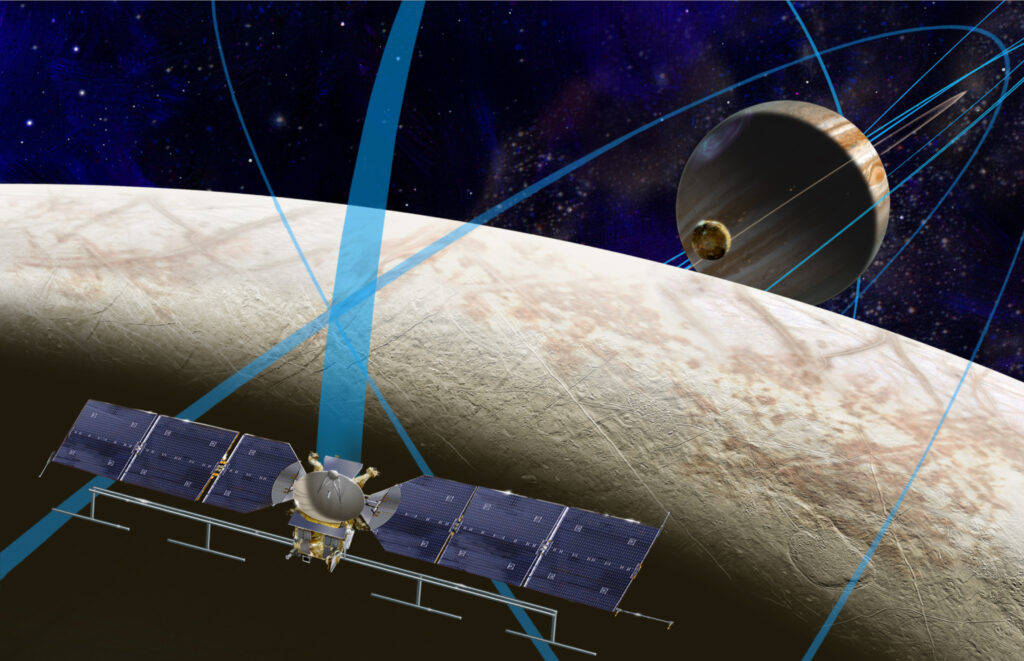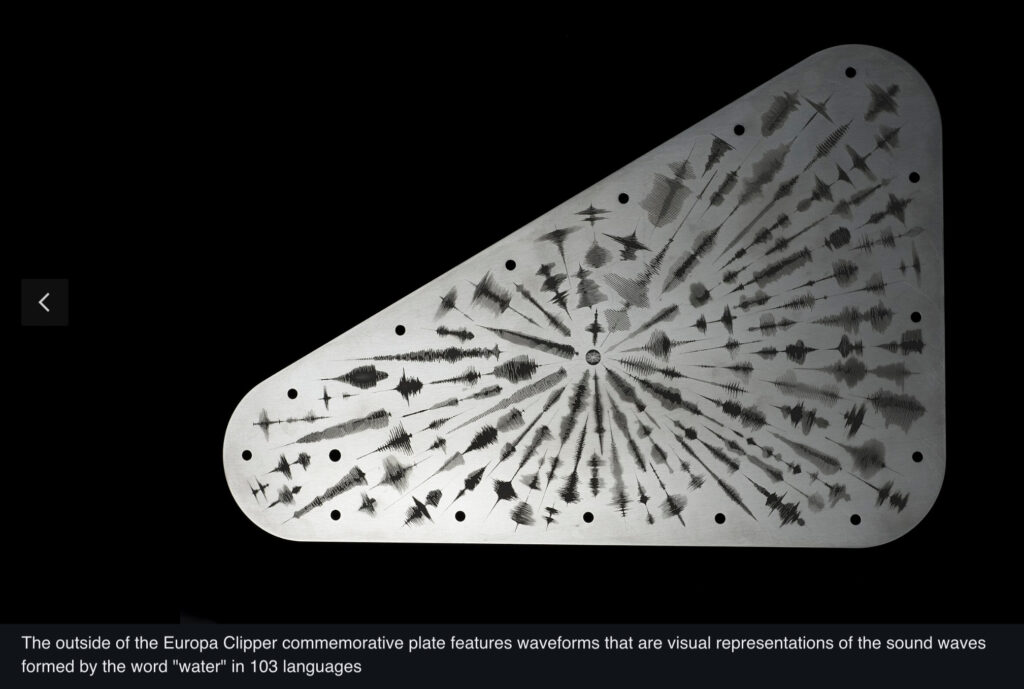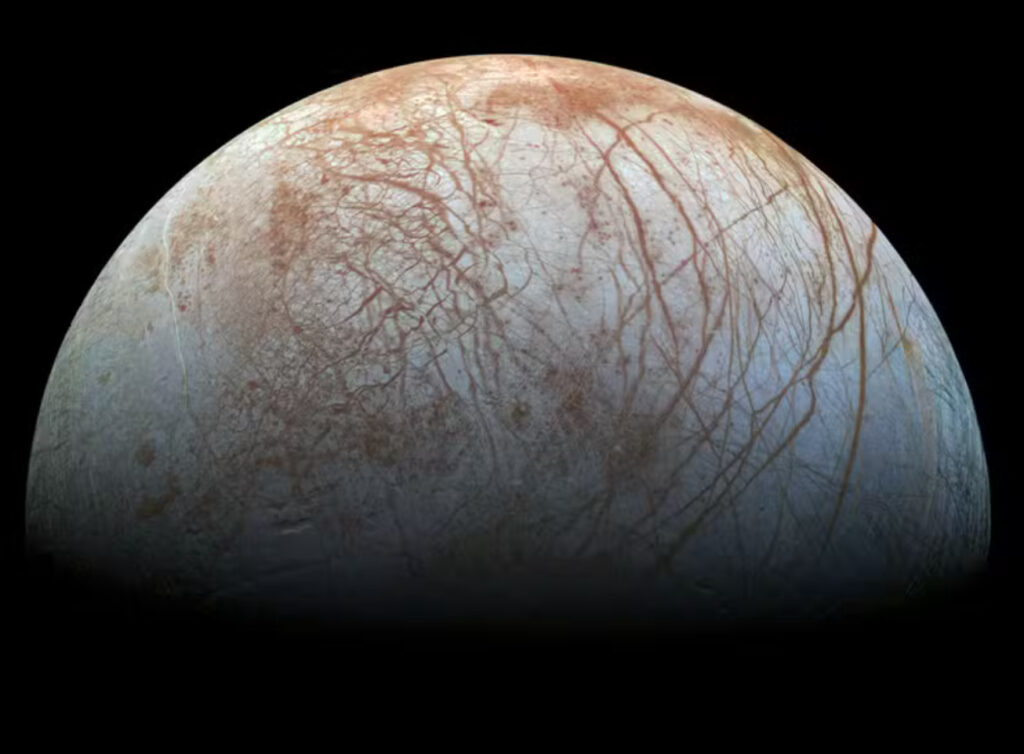
ChatGPT:
🚀 NASA’s Europa Clipper Mission: Exploring Life on Jupiter’s Icy Moon
🌍 Introduction
NASA’s ambitious Europa Clipper mission, launched on October 14, 2024, marks a significant step in humankind’s quest to understand whether life could exist beyond Earth. Headed for Jupiter’s moon Europa, the spacecraft aims to explore its icy surface and vast subsurface ocean. By investigating the critical ingredients for life, scientists hope to unravel Europa’s secrets and assess its potential to harbor life in the present day. In collaboration with ESA’s Juice mission, the Europa Clipper will provide unprecedented insights into the habitability of not only Europa but potentially other icy moons of Jupiter as well.
🛰️ Mission Overview: Launch and Journey to Europa
On October 14, 2024, NASA’s Europa Clipper launched from Kennedy Space Center in Florida aboard SpaceX’s Falcon Heavy rocket. This mission, valued at $5.2 billion, represents NASA’s largest interplanetary exploration to date. Europa Clipper is destined for Jupiter’s moon, Europa, which is widely believed to host a liquid water ocean beneath its icy crust. The spacecraft will take about 5.5 years to reach Europa, arriving in April 2030 after traveling an astounding 2.9 billion kilometers (1.8 billion miles).
One of the most striking features of the Europa Clipper is its size: with solar panels extending over 30 meters (100 feet) in width, the probe needs this immense surface area to capture sufficient sunlight to power its systems far from the Sun. Over its mission duration, which could extend up to 4 years, the spacecraft will perform 49 flybys of Europa, getting as close as 25 kilometers (15 miles) to the moon’s icy surface.
🔬 Scientific Objectives: Probing the Habitability of Europa
Europa Clipper’s core goal is not to find life directly but to assess whether Europa’s environment could support life. The mission focuses on investigating three fundamental ingredients for life as we know it: water, energy, and essential chemical compounds. Europa’s vast ocean, hidden beneath a thick layer of ice, is believed to contain twice as much water as all of Earth’s oceans combined.
Key Instruments and Investigations:
• Spectrographs and Cameras: These tools will capture detailed images and spectra of Europa’s surface, providing a detailed map of the moon’s icy landscape.
• Radar: Capable of penetrating Europa’s ice crust, the radar will measure the thickness of the ice and the depth of the ocean beneath.
• Magnetometer: This device will study Europa’s magnetic field, offering insights into the ocean’s salinity and how it interacts with the ice above.
Europa Clipper will investigate whether water from the ocean below rises to the surface through cracks in the ice. Understanding this interaction could reveal more about the moon’s internal structure, and whether heat and chemicals from the ocean floor might support primitive microbial life.
🌊 The Search for Life: What Makes Europa a Prime Target?
Europa’s status as a prime candidate for hosting life hinges on its unique characteristics. The icy moon, about the size of Earth’s moon, was first observed closely in 1979 by NASA’s Voyager spacecraft. Later, the Galileo probe (1990s) provided compelling evidence that Europa’s smooth, young surface might hide a liquid ocean beneath.
The Europa Clipper mission will examine whether conditions in this ocean are favorable for life. Specifically, scientists are interested in three factors:
1. Water: The presence of water is crucial for life. Europa’s suspected ocean, beneath a 10 to 15-mile thick icy shell, could be 80 miles deep, containing saltwater similar to Earth’s oceans.
2. Energy: Life needs energy sources to thrive. On Europa, energy may come from tidal heating, a process caused by Jupiter’s immense gravitational pull. This friction could heat Europa’s core, driving chemical reactions and possibly hydrothermal activity on the ocean floor.
3. Chemical Compounds: Organic molecules, which are the building blocks of life, are another essential ingredient. Europa’s thin atmosphere and interaction with Jupiter’s magnetic field may provide the necessary energy to create these compounds. Radiation from Jupiter could split water molecules into oxygen and hydrogen, fueling chemical reactions that sustain life.
Europa’s potential habitability makes it an intriguing target, not just for future exploration but for a broader understanding of life’s potential in icy environments across the universe.
⚠️ The Challenge of Radiation: Protecting the Probe
A significant hurdle in Europa Clipper’s mission is the intense radiation around Jupiter. The planet’s magnetic field traps high-energy charged particles that create a radiation environment hazardous for spacecraft. Each flyby will expose the Europa Clipper to radiation equivalent to a million chest X-rays.
To protect its sensitive electronics, the spacecraft’s core systems are encased in a thick aluminum vault. Instead of orbiting Europa directly, which would increase exposure to radiation, the probe will orbit Jupiter and perform periodic flybys of the moon, limiting the time spent in the most hazardous areas. Despite these precautions, each pass will still subject the spacecraft to high doses of radiation, posing ongoing risks throughout the mission.
📅 Timeline: The Road Ahead for Europa Clipper
The Europa Clipper’s journey will take about five and a half years, with the spacecraft expected to reach Europa by April 2030. Upon arrival, it will begin a four-year mission of flybys and data collection. The spacecraft’s orbits around Jupiter will allow it to pass Europa 49 times, coming within just 25 kilometers (15 miles) of the moon’s surface at the closest approach.
During these flybys, the spacecraft will map the surface, probe the ice, and analyze the subsurface ocean. The data it collects will provide a wealth of information about Europa’s potential to support life.
🌍 Europa and Beyond: The Broader Implications of the Mission
Europa Clipper is just one part of a broader effort to understand whether moons in the outer solar system could harbor life. The mission will operate alongside ESA’s Juice (Jupiter Icy Moons Explorer), which will focus on Europa’s neighboring moons, Ganymede and Callisto. Together, these missions will explore several of Jupiter’s icy satellites, all of which are suspected to have subsurface oceans.
Ganymede, the largest moon in the solar system, and Callisto, another of Jupiter’s moons, also show signs of having liquid water beneath their surfaces. By studying multiple moons with similar characteristics, scientists hope to answer the question of whether these icy worlds could be habitable.
If both Europa and Earth are found to be habitable, it would imply that life-sustaining environments are more common in the universe than previously thought. As Europa Clipper program scientist Curt Niebur notes, this mission could “open up a huge new paradigm for searching for life in the galaxy.”
🔭 Future Missions: From Europa to Titan and Beyond
While the Europa Clipper mission targets one of the most promising candidates for life in the solar system, future missions will extend the search to other icy worlds. NASA’s Dragonfly mission to Saturn’s moon Titan, set to launch in 2028, will explore another environment that could support life.
Titan has lakes and rivers of methane and ethane on its surface, and its thick atmosphere contains complex organic molecules. The Dragonfly mission will analyze these chemicals and look for prebiotic conditions that might have fostered the development of life. Dragonfly, set to arrive in 2034, will investigate whether Titan’s surface and atmosphere could host life or contain the building blocks of life.
💡 Conclusion: Europa Clipper’s Legacy
The Europa Clipper mission promises to be a monumental step in the search for life beyond Earth. By studying the icy surface and hidden ocean of Europa, NASA will gather crucial data on the moon’s habitability. If Europa contains the right mix of water, energy, and chemical compounds, it could change the way we view life’s potential across the universe.
Through its collaboration with ESA’s Juice probe and future missions like Dragonfly, NASA is poised to make the next decade a transformative period in astrobiology. Even if the Europa Clipper doesn’t find definitive signs of life, its findings will lay the groundwork for future exploration and the possibility that life could exist on other moons, planets, or even in distant solar systems.
The question of whether we are alone in the universe remains open, but Europa Clipper is poised to bring us closer to the answer.

Q&A: FAQs about NASA’s Europa Clipper Mission
Q1: What is the Europa Clipper mission?
The Europa Clipper mission is NASA’s spacecraft designed to explore Jupiter’s icy moon, Europa. Its primary goal is to investigate whether Europa has the necessary conditions to support life by analyzing its surface and subsurface ocean. The mission will study the moon’s ice shell, ocean, and potential for habitability.
Q2: When was Europa Clipper launched, and when will it arrive at Europa?
Europa Clipper was launched on October 14, 2024, from Kennedy Space Center aboard a SpaceX Falcon Heavy rocket. It is expected to reach Europa in April 2030 after a journey of 2.9 billion kilometers (1.8 billion miles).
Q3: Why is Europa an important target for studying life beyond Earth?
Europa is a prime candidate for the search for life because it is believed to have a vast subsurface ocean beneath its icy crust. This ocean may contain twice as much water as all of Earth’s oceans combined, and scientists believe the conditions might support microbial life if the right chemical and energy sources are present.
Q4: Will Europa Clipper search for life on Europa?
No, Europa Clipper is not designed to directly search for life. Instead, it will assess whether Europa is a habitable environment by looking for key factors like water, energy sources, and essential chemicals. These factors are necessary to determine if life could exist there, but finding actual life would require a future mission.
Q5: How will the probe explore Europa’s surface and ocean?
Europa Clipper is equipped with nine scientific instruments, including cameras, radar, and a magnetometer. These tools will map the surface, penetrate the ice to measure its thickness and the depth of the ocean, and analyze the moon’s magnetic field. This data will help scientists understand how Europa’s surface and subsurface interact.
Q6: How many flybys of Europa will the spacecraft make?
The Europa Clipper will make 49 close flybys of Europa over its mission, coming as close as 25 kilometers (15 miles) from the surface. These flybys will allow the probe to gather detailed data about Europa’s ice shell and subsurface.
Q7: What challenges does the mission face, especially from radiation?
One of the biggest challenges is the intense radiation around Jupiter. The planet’s magnetic field traps high-energy particles that can damage the spacecraft’s electronics. Europa Clipper’s systems are protected by a special aluminum vault, and the probe will orbit Jupiter, not Europa, to limit radiation exposure.
Q8: What is the significance of the collaboration between Europa Clipper and ESA’s Juice mission?
NASA’s Europa Clipper and ESA’s Juice (Jupiter Icy Moons Explorer) mission will work together to study Jupiter’s moons. While Europa Clipper focuses on Europa, Juice will study Ganymede and Callisto. This collaboration will provide a comprehensive understanding of the habitability of Jupiter’s moons.
Q9: What makes Europa’s ocean unique, and why do scientists believe it could support life?
Europa’s ocean is unique because it is hidden beneath a thick ice layer and may be in contact with the moon’s rocky core, creating the potential for chemical interactions that support life. The ocean is also thought to be salty, similar to Earth’s oceans, and could contain twice as much water as all of Earth’s oceans combined.
Q10: What happens after the Europa Clipper mission?
If Europa Clipper finds that Europa has the necessary ingredients for life, future missions could be designed to directly search for life. These missions might explore the ocean more closely or sample the water plumes that are thought to erupt from beneath Europa’s icy surface. Additionally, NASA’s Dragonfly mission to Saturn’s moon Titan will continue the search for habitable environments elsewhere in the solar system.
Q&A: FAQs about the Solar System’s Hidden Oceans
Q1: What are hidden oceans in the solar system?
Hidden oceans refer to large bodies of liquid water that exist beneath the icy surfaces of moons or dwarf planets in the solar system. These oceans are concealed under thick ice layers, making them difficult to detect directly, but scientists have strong evidence that several moons in the outer solar system harbor such oceans.
Q2: Which moons in the solar system are believed to have subsurface oceans?
Several moons in the solar system are believed to host subsurface oceans, including Jupiter’s moons Europa, Ganymede, and Callisto, and Saturn’s moons Enceladus, Titan, and possibly Mimas. These moons have thick ice coverings, but beneath the surface, there may be vast oceans of liquid water.
Q3: How do scientists know these oceans exist if they are hidden under ice?
Scientists detect hidden oceans by studying the moons’ magnetic fields, surface features, and gravity. For example, disturbances in a moon’s magnetic field can indicate the presence of a conductive fluid, like saltwater. Additionally, surface features such as cracks, plumes of water vapor, and geological activity suggest interactions between the surface and the subsurface ocean.
Q4: Why are subsurface oceans important in the search for extraterrestrial life?
Subsurface oceans are important because water is essential for life as we know it. If these oceans contain the right chemical ingredients and sources of energy, they could potentially harbor life, especially in the form of microbial organisms. The search for life beyond Earth often focuses on places with liquid water, making these oceans prime targets.
Q5: Which moon is the best candidate for finding life in a hidden ocean?
Europa, one of Jupiter’s moons, is considered the best candidate for finding life in its hidden ocean. Its ocean is thought to be in contact with a rocky core, which could provide the necessary chemical reactions to sustain life. Plumes of water detected on Europa also suggest that the ocean interacts with the surface, potentially bringing life-sustaining compounds to accessible areas.
Q6: What role do tidal forces play in maintaining these hidden oceans?
Tidal forces from the gravitational pull of nearby planets, like Jupiter and Saturn, create friction inside these moons. This friction generates heat, preventing the subsurface oceans from freezing completely. For example, Europa and Enceladus experience significant tidal heating, which keeps their oceans in a liquid state despite being far from the Sun.
Q7: What evidence supports the existence of a subsurface ocean on Enceladus?
Enceladus, a moon of Saturn, shows strong evidence of a subsurface ocean through its active water plumes, which erupt from its south pole. These plumes contain water vapor, ice particles, and organic molecules. The Cassini spacecraft, which flew through these plumes, detected hydrogen and other chemicals that suggest hydrothermal activity on the ocean floor, providing potential energy for life.
Q8: How deep are the hidden oceans beneath these moons’ ice shells?
The depth of hidden oceans varies depending on the moon. For example, Europa’s ocean is estimated to be 80 miles (130 kilometers) deep, beneath an ice shell that is 10 to 15 miles (15 to 25 kilometers) thick. On Ganymede, the ocean might be even deeper, while Enceladus’ ocean is believed to be about 60 miles (100 kilometers) deep under a thinner ice crust.
Q9: Could these hidden oceans support complex life, like on Earth?
While the potential for life exists in these hidden oceans, it is likely limited to microbial life. The extreme conditions, lack of sunlight, and potential for high pressure beneath the ice make it unlikely that complex life forms, such as fish or other large organisms, could thrive in these environments. However, some scientists speculate that hydrothermal vents on the ocean floors, similar to those on Earth, could provide the energy needed to sustain simple organisms.
Q10: What future missions will explore these hidden oceans?
Several upcoming missions aim to explore moons with hidden oceans. NASA’s Europa Clipper mission, launching in 2024, will study Europa in detail, looking for signs of habitability. ESA’s Juice mission, launching in 2023, will focus on Ganymede, Callisto, and Europa. NASA’s Dragonfly mission to Titan, set to launch in 2028, will investigate the moon’s atmosphere and surface for signs of life. These missions will provide critical data to understand whether hidden oceans could support life.

